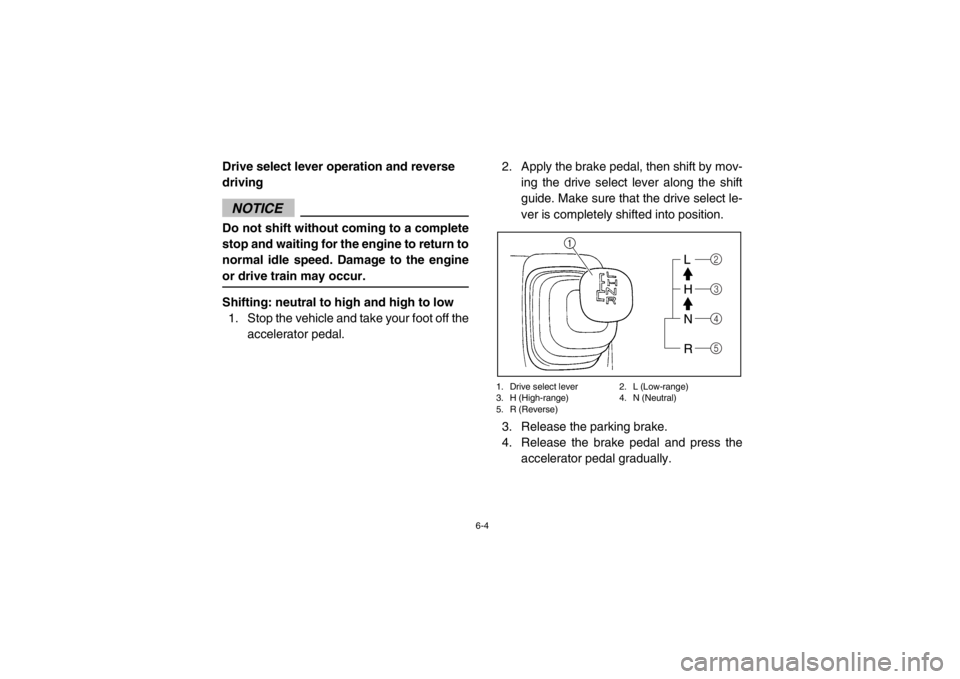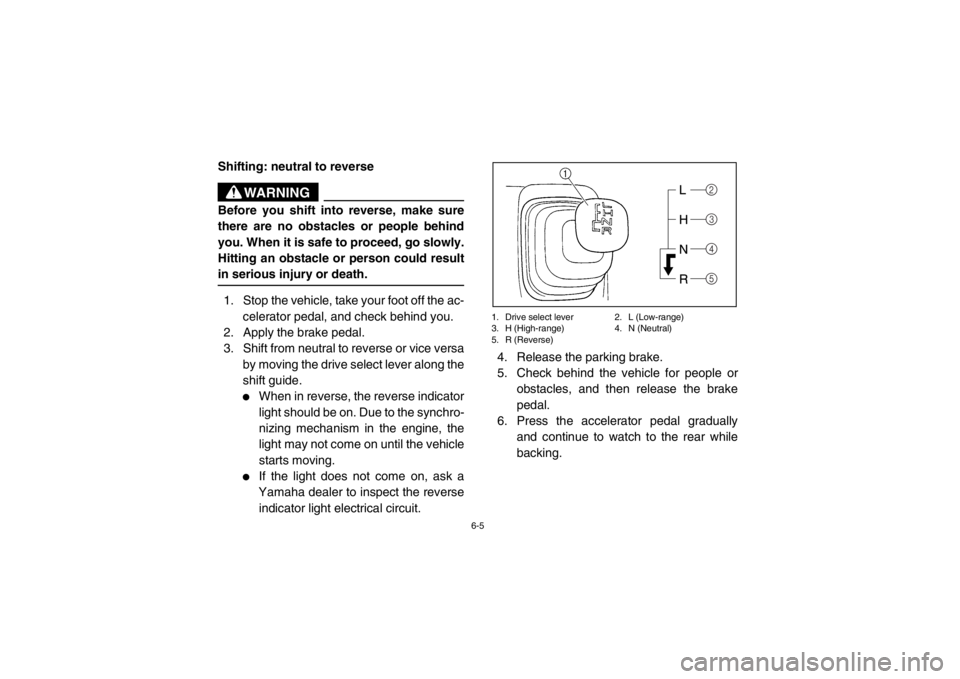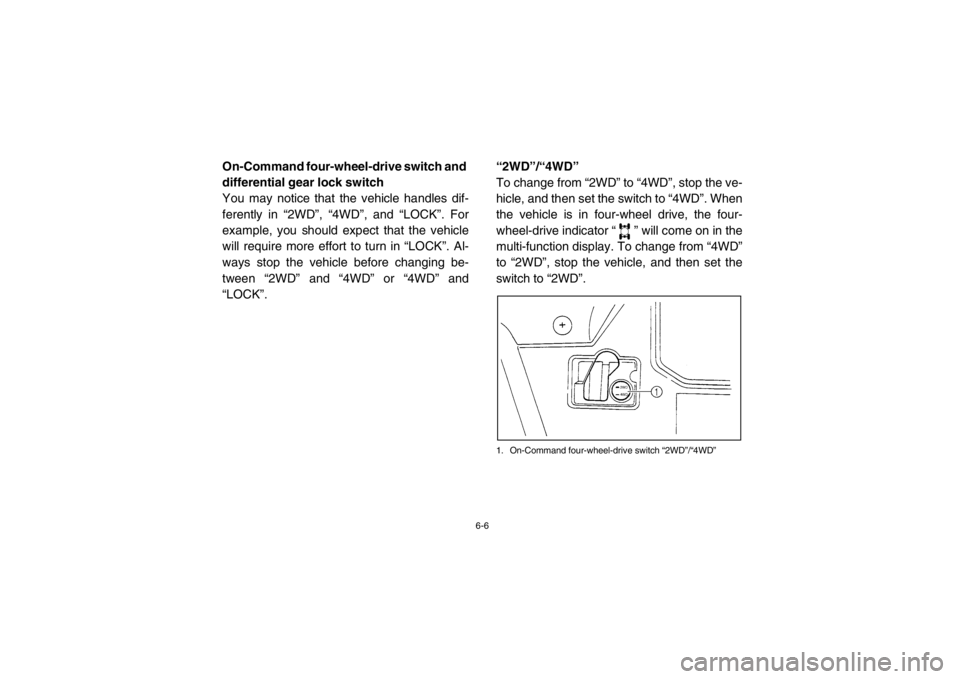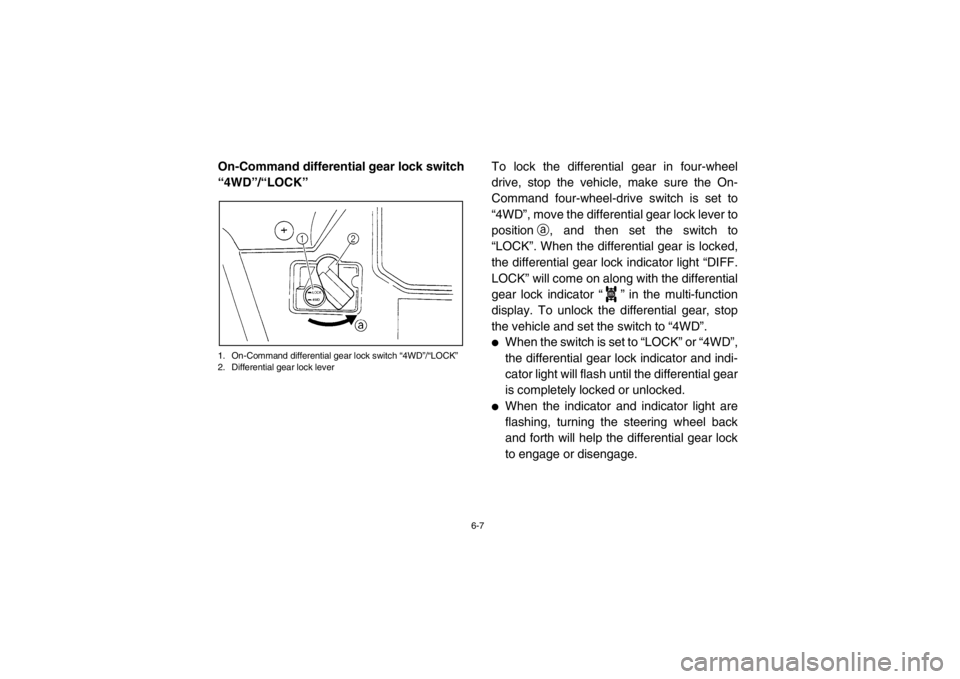YAMAHA RHINO 700 2013 Manual Online
Manufacturer: YAMAHA, Model Year: 2013, Model line: RHINO 700, Model: YAMAHA RHINO 700 2013Pages: 188, PDF Size: 4.9 MB
Page 81 of 188

6-4
Drive select lever operation and reverse
drivingNOTICEDo not shift without coming to a complete
stop and waiting for the engine to return to
normal idle speed. Damage to the engine
or drive train may occur.Shifting: neutral to high and high to low1. Stop the vehicle and take your foot off the
accelerator pedal. 2. Apply the brake pedal, then shift by mov-
ing the drive select lever along the shift
guide. Make sure that the drive select le-
ver is completely shifted into position.
1. Drive select lever 2. L (Low-range)
3. H (High-range) 4. N (Neutral)
5. R (Reverse)3. Release the parking brake.
4. Release the brake pedal and press theaccelerator pedal gradually.
2
5 4
3
1RB7A_EE.book Page 4 Tuesday, April 24, 2012 9:07 AM
Page 82 of 188

6-5
Shifting: neutral to reverse
WARNING
Before you shift into reverse, make sure
there are no obstacles or people behind
you. When it is safe to proceed, go slowly.
Hitting an obstacle or person could result
in serious injury or death.1. Stop the vehicle, take your foot off the ac-celerator pedal, and check behind you.
2. Apply the brake pedal.
3. Shift from neutral to reverse or vice versa
by moving the drive select lever along the
shift guide.
●
When in reverse, the reverse indicator
light should be on. Due to the synchro-
nizing mechanism in the engine, the
light may not come on until the vehicle
starts moving.
●
If the light does not come on, ask a
Yamaha dealer to inspect the reverse
indicator light electrical circuit.
1. Drive select lever 2. L (Low-range)
3. H (High-range) 4. N (Neutral)
5. R (Reverse)4. Release the parking brake.
5. Check behind the vehicle for people or obstacles, and then release the brake
pedal.
6. Press the accelerator pedal gradually
and continue to watch to the rear while
backing.
2
5 4
3
1RB7A_EE.book Page 5 Tuesday, April 24, 2012 9:07 AM
Page 83 of 188

6-6
5B410009On-Command four-wheel-drive switch and
differential gear lock switch
You may notice that the vehicle handles dif-
ferently in “2WD”, “4WD”, and “LOCK”. For
example, you should expect that the vehicle
will require more effort to turn in “LOCK”. Al-
ways stop the vehicle before changing be-
tween “2WD” and “4WD” or “4WD” and
“LOCK”.“2WD”/“4WD”
To change from “2WD” to “4WD”, stop the ve-
hicle, and then set the switch to “4WD”. When
the vehicle is in four-wheel drive, the four-
wheel-drive indicator “ ” will come on in the
multi-function display. To change from “4WD”
to “2WD”, stop the vehicle, and then set the
switch to “2WD”.
1. On-Command four-wheel-drive switch “2WD”/“4WD”
1RB7A_EE.book Page 6 Tuesday, April 24, 2012 9:07 AM
Page 84 of 188

6-7
On-Command differential gear lock switch
“4WD”/“LOCK”1. On-Command differential gear lock switch “4WD”/“LOCK”
2. Differential gear lock lever
To lock the differential gear in four-wheel
drive, stop the vehicle, make sure the On-
Command four-wheel-drive switch is set to
“4WD”, move the differential gear lock lever to
positiona, and then set the switch to
“LOCK”. When the differential gear is locked,
the differential gear lock indicator light “DIFF.
LOCK” will come on along with the differential
gear lock indicator “ ” in the multi-function
display. To unlock the differential gear, stop
the vehicle and set the switch to “4WD”.●
When the switch is set to “LOCK” or “4WD”,
the differential gear lock indicator and indi-
cator light will flash until the differential gear
is completely locked or unlocked.
●
When the indicator and indicator light are
flashing, turning the steering wheel back
and forth will help the differential gear lock
to engage or disengage.
DIFF.
LOCK
1RB7A_EE.book Page 7 Tuesday, April 24, 2012 9:07 AM
Page 85 of 188

6-8
●
Driving before the differential gear is prop-
erly engaged or disengaged (e.g., when the
indicator and indicator light are flashing) will
cause the engine speed to be limited until
the differential gear is completely engaged
or disengaged.
EVU01210Parking
When parking, stop the engine and shift the
drive select lever into the neutral position. Ap-
ply the parking brake to help prevent the vehi-
cle from rolling. See pages 7-18–7-19 for
more information on parking and parking on a
slope.
1RB7A_EE.book Page 8 Tuesday, April 24, 2012 9:07 AM
Page 86 of 188

6-9
EVU00630Loading
Take extra precautions when driving with a
load or trailer. Follow these instructions and
always use common sense and good judg-
ment when carrying cargo or towing a trailer.
Prepare your load or trailer
WARNING
Improper loading or towing can increase
the risk of loss of control, an overturn, or
other accident:●
Do not exceed the Maximum Loading
Limits for the vehicle (see page 6-10
and vehicle labeling).
●
Keep weight in the cargo bed centered
side to side, and as low and as far for-
ward as possible. Top-heavy loads in-
crease the risk of overturn. Be sure
cargo is secured – a loose load could
change handling unexpectedly or
strike occupants.
●
Do not exceed the maximum tongue
weight.
●
Make sure the load does not interfere
with your control or ability to see
where you are going.
●
Tie down cargo in the trailer securely.
Make sure cargo in the trailer cannot
move around. A shifting load can
cause an accident.
Use the hooks equipped on the cargo bed to
tie down loads.
Choose a trailer hitch drawbar designed for
use with a 5 cm (2 in) receiver. (See page
4-36 for more information.)
1RB7A_EE.book Page 9 Tuesday, April 24, 2012 9:07 AM
Page 87 of 188

6-10
You can measure tongue weight with a bath-
room scale. Put the tongue of the loaded trail-
er on the scale with the tongue at hitch height.
Adjust the load in the trailer, if necessary, to
reduce the weight on hitch. If you are carrying
cargo and towing a trailer, include the tongue
weight in the maximum vehicle load limit.Operating when loaded with cargo or tow-
ing a trailer
Drive more slowly than you would without a
load. The more weight you carry, the slower
you should go. Although conditions vary, it is
good practice to keep the vehicle in low gear
whenever you are carrying heavier loads or
when towing a trailer.
WARNING
Carrying loads or towing a trailer can in-
crease the risk of loss of control, an over-
turn, or other accident. To reduce the risk
of an accident:●
Reduce speed, operate in low gear
only, and allow more room to stop. A
heavier vehicle takes longer to stop.
●
Avoid hills and rough terrain. Choose
terrain carefully. Use extreme caution
when towing or carrying a load on in-
clines.
●
Turn gradually and go slowly.
MAXIMUM LOADING LIMIT●
Vehicle loading limit (total weight of
cargo, operator, passenger and
accessories and tongue weight):
YXR7FD 367.0 kg (809 lb)
YXR7FSPD 359.0 kg (791 lb)
YXR700FAD 367.0 kg (809 lb)
●
Cargo bed: 181 kg (400 lb)
●
Trailer hitch:
Pulling load (total weight of trailer and
cargo): 550 kg (1212 lb)
Tongue weight (vertical weight on trailer
hitch point): 50 kg (110 lb)
1RB7A_EE.book Page 10 Tuesday, April 24, 2012 9:07 AM
Page 88 of 188

6-11
Pulling something other than a trailer
Yamaha recommends that loads be transport- ed in the bed or in a trailer. If you need to
move an object a short distance use a winch
and follow the winch manufacturer’s instruc-
tions.
If you choose to use something other than a
winch use extreme caution, follow the manu-
facturer’s instructions for that product, and
only attach to the hitch or hitch bracket of the
Rhino. WARNING! Improperly pulling can
cause serious injury or death. Never ex-
ceed the Pulling Load limit of the Rhino.
Avoid pulling on inclines.
Pulling objects on the ground can be more
hazardous than pulling a trailer. It may be dif-
ficult to predict how the load will affect vehicle
operation. That effect could also change de-
pending upon terrain or what obstacles might
be in the object’s path.1RB7A_EE.book Page 11 Tuesday, April 24, 2012 9:07 AM
Page 89 of 188

7-1
1
2
3
4
5
67
8
9
10
11
12
13
14
5B470010
1-
BASIC GUIDE FOR SAFE USE
As a Rhino owner you are responsible for the
safe and proper operation of this vehicle.
Read this chapter and review the safety in-
structions in Chapter 2 before operating the
vehicle. Use these chapters and the labels on
the vehicle to instruct new operators and pas-
sengers. Do not allow anyone else to operate
the vehicle or ride as a passenger if you are
unsure that he/she is willing and able to follow
these instructions.
WARNING
Follow these instructions to reduce your
risk of an accident and to reduce the risk
of serious injury or death in the event of an
accident.
KNOW YOUR VEHICLE
This off-road vehicle will handle and maneu-
ver differently from cars, ATVs, go-carts, golf-
cars and grounds-keeping vehicles. The
Rhino has higher ground clearance and other features to handle rugged terrain, and, as a
result, can overturn in situations where some
vehicles may not. This would include vehicles
made primarily for pavement, roads, im-
proved paths, or grounds-keeping. If you do
not use care in maneuvering the Rhino, you
can cause it to roll over even on flat, open ar-
eas.
1RB7A_EE.book Page 1 Tuesday, April 24, 2012 9:07 AM
Page 90 of 188

7-2
Doing things with a Rhino that some people
do for thrills in other vehicles (such as side-
ways sliding, skidding, back-wheel sliding, or
donuts) have led to side rollovers. These roll-
overs can result in crushed limbs and other
serious injuries or death to drivers or passen-
gers.
As the owner/operator, it is your responsibility
to protect yourself and your passenger from
accidents, including rollovers. The Rhino has
many features, including a protective struc-
ture and seat belts, to help protect occupants,
but the best way to avoid injuries is to avoid
accidents. There is a risk of injury or death in
any accident, even with these safety features.1RB7A_EE.book Page 2 Tuesday, April 24, 2012 9:07 AM